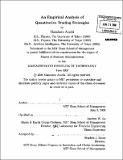| dc.contributor.advisor | Andrew W. Lo. | en_US |
| dc.contributor.author | Aiuchi, Masaharu | en_US |
| dc.contributor.other | Sloan School of Management. | en_US |
| dc.date.accessioned | 2009-01-30T16:46:58Z | |
| dc.date.available | 2009-01-30T16:46:58Z | |
| dc.date.copyright | 2008 | en_US |
| dc.date.issued | 2008 | en_US |
| dc.identifier.uri | http://hdl.handle.net/1721.1/44439 | |
| dc.description | Thesis (M.B.A.)--Massachusetts Institute of Technology, Sloan School of Management, 2008. | en_US |
| dc.description | Includes bibliographical references (p. 277-280). | en_US |
| dc.description.abstract | Along with the increasing computing power, growing availability of various data streams, introduction of the electronic exchanges, decreasing trading costs and heating-up competition in financial investment industry, quantitative trading strategies or quantitative trading rules have been evolving rapidly in a few decades. They challenge the Efficient Market Hypothesis by trying to forecast future price movements of risky assets from the historical market information in algorithmic ways or in statistical ways. They try to find some patters or trends from the historical data and use them to beat the market benchmark. In this research, I introduce several quantitative trading strategies and investigate their performances empirically i.e. by executing back-tests assuming that the S&P 500 stock index is a risky asset to trade. The strategies utilize the historical data of the stock index itself, trading volume movement, risk-free rate movement and implied volatility movement in order to generate buy or sell trading signals. Then I attempt to articulate and decompose the source for successes of some strategies in the back-tests into several factors such as trend patterns or relationships between market information variables in intuitive way. Some strategies recorded higher performances than the benchmark in the back-tests, however it is still a problem how we can distinguish these winner strategies beforehand from the losers at the beginning of our investment horizon. Human discretion such as macro view on the future market trend is considered to still play an important role for quantitative trading to be successful in the long-run. | en_US |
| dc.description.statementofresponsibility | by Masaharu Aiuchi. | en_US |
| dc.format.extent | 280 p. | en_US |
| dc.language.iso | eng | en_US |
| dc.publisher | Massachusetts Institute of Technology | en_US |
| dc.rights | M.I.T. theses are protected by
copyright. They may be viewed from this source for any purpose, but
reproduction or distribution in any format is prohibited without written
permission. See provided URL for inquiries about permission. | en_US |
| dc.rights.uri | http://dspace.mit.edu/handle/1721.1/7582 | en_US |
| dc.subject | Sloan School of Management. | en_US |
| dc.title | An empirical analysis of quantitative trading strategies | en_US |
| dc.title.alternative | rise and fall : evolution of trading strategies | en_US |
| dc.type | Thesis | en_US |
| dc.description.degree | M.B.A. | en_US |
| dc.contributor.department | Sloan School of Management | |
| dc.identifier.oclc | 294907447 | en_US |
